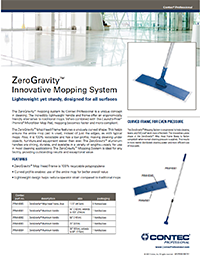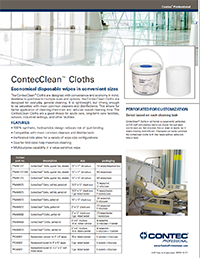
When in Doubt, Focus on the Fundamentals
CDC reports there are almost 3 million antibiotic-resistant infections annually with over 35,000 people dying because of them.
After two years of pandemic vigilance, life seems to be easing towards normalcy. Offices are opening up, masks are coming down, and access to people and places is growing. The widespread availability of vaccines and other positive developments have made the public more confident about avoiding possible exposure to Covid. For example, the hand sanitizer stands that seemed to be everywhere when lockdowns started have been packed away or now stand empty. Airlines are no longer handing out packets of disinfectant wipes for passengers to clean their seats. The compulsion to keep germs at bay has lessened significantly.
Those working in healthcare related fields, however, know that Covid-19 isn’t the only deadly disease out there. Experts are keeping an eye on new, emerging viruses as well as better known ones, such as Ebola and hepatitis. Add to this the growing list of antibiotic-resistant bacteria and fungi that continue to present major health problems. The CDC reports that there are almost 3 million antibiotic-resistant infections annually with over 35,000 people dying because of them.1 Many of these infections originate in hospitals and other places where patients receive care. For instance, carbapenem-resistant Acinetobacter, one of these “superbugs”, is almost always found in people who’ve recently received treatment at a healthcare facility.
Besides having more challenging pathogens to clean, environmental services professionals also face a wide variety of new machines and technology to consider. Electrostatic sprayers, ultraviolet radiation, and antiviral coatings gained lots of attention during the pandemic. Evaluating what is the best methodology to meet a facility’s cleaning requirements takes time and resources that many department leaders just don’t have.
What, then, is an EVS team to do?
When the demands of critical cleaning become overwhelming, it’s always a safe bet to focus on the fundamentals of cleaning. The basic elements of any good cleaning, disinfecting, and sanitizing protocol should be repeatable and provide good results consistently. Here are some of the core ideas that all effective cleaning programs incorporate:
- Break the Chain of Infection – Interrupting the path a pathogen takes from one person to another is key to reducing the spread of disease. There are simple steps along the way, such as performing proper hand hygiene and covering coughs, that hinder the infection process. Learn more about the other links in the chain with
this video from the Association of Healthcare Environment.
- Let Chemicals Dwell – When it comes to breaking the chain of infection, cleaning and
disinfecting are key steps. Many people make the mistake of not reading the labels of the chemicals they use. If a disinfectant is wiped away too quickly, the active ingredients might not have had time to work. Dwell or contact time is the minimum time a disinfectant must remain on a surface to achieve optimum results. Read all labels of cleaning chemicals to ensure that they’re not being misused.
- Clean Systematically and Directionally – Cleaning protocols that achieve positive outcomes consistently rely on systematic approaches. This means cleaning from clean to dirty, top to bottom, left to right, etc. The value of this is better efficiency, but it also helps with replicating optimal results from area to area, technician to technician. Key areas aren’t overlooked, and cross-contamination is greatly reduced.
- Remember High Touch Surfaces – Tackling large surface areas is often the main focus for EVS teams, but don’t forget about the smaller surfaces that are touched by multiple people multiple times a day. These high touch areas, such as light switches, bed rails, chair arms, etc., are easy to skip. However, if someone hasn’t practiced proper hand hygiene, these are the places where pathogens can reside. Using a
disposable wipe to properly clean and disinfect these areas can help reduce the spread of disease greatly by eliminating transfer areas for germs and bacteria.
- Reduce Variability in Tool Performance – Just as cleaning systematically reduces the variability in results, reducing the opportunities for human error can help maintain the highest levels of cleaning performance. Using disposable wipes, for example, eliminates the question of whether a reused wipe was laundered at the right temperatures or with the proper amount of detergent. These washing issues can affect the performance of microfiber which is sensitive to high heat and bleaching agents.
Single-use microfiber mop pads provide EVS professionals with an unused mop each time, unlike mops that must be laundered after use. The reduction of variability in the tool at the onset of cleaning carries over into more consistent positive outcomes.
EVS teams and cleaning professionals will continue to face greater challenges when it comes to critical cleaning areas. However, understanding and excelling in the fundamentals are what makes a robust program succeed long-term. They might not seem exciting, but they are the foundation for superior results. Never getting bored with the basics of cleaning can help get EVS back on the track to success when the environment becomes overwhelming.
If your facility would like to revisit the fundamentals of critical cleaning with a trusted expert, Contec Professional can help. Please
References
- https://www.cdc.gov/drugresistance/biggest-threats.html#carp
Newsletter
Stay prepared and protected with Infection Control Today's newsletter, delivering essential updates, best practices, and expert insights for infection preventionists.








